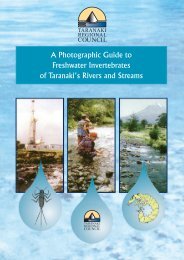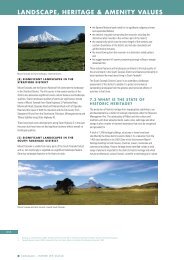Annual report 2006-2007 - Taranaki Regional Council
Annual report 2006-2007 - Taranaki Regional Council
Annual report 2006-2007 - Taranaki Regional Council
Create successful ePaper yourself
Turn your PDF publications into a flip-book with our unique Google optimized e-Paper software.
mayflies, elmid beetles, Archichauliodes dobsonfly, Hydrobiosis, Pycnocentrodes and<br />
Costachorema caddisflies and Aphrophila cranefly); and four ‘tolerant’ taxa (oligochaete<br />
worms, Aoteapsyche caddisfly, and Maoridiamesa and orthoclad midges), generally similar to<br />
taxa characteristic of upstream sites. Few significant differences in individual taxon<br />
abundances between adjacent sites (F and G) were evident, and despite increases in the<br />
abundance of some ‘moderately sensitive’ taxa (Table 3), and a decrease in abundance of<br />
some ‘tolerant’ taxa, there was little difference in the SQMCIs score at this site, compared to<br />
site F (and most other upstream sites). The SQMCIs value of 5.4 was significantly higher than<br />
the median of previous scores at this site (Table 2), which was indicative of no recent<br />
impacts of the power station's discharges on the macroinvertebrate community of the<br />
Kahouri Stream.<br />
MCI value<br />
140<br />
120<br />
100<br />
80<br />
60<br />
40<br />
20<br />
0<br />
Number of taxa and MCI values in the Kahouri Stream 80m d/s<br />
Stratford CC pow er station discharge (KHI000465)<br />
Jan-88<br />
Jan-89<br />
Jan-90<br />
Jan-91<br />
Jan-92<br />
Jan-93<br />
Jan-94<br />
Jan-95<br />
Jan-96<br />
Jan-97<br />
Jan-98<br />
Jan-99<br />
Jan-00<br />
Jan-01<br />
Jan-02<br />
Jan-03<br />
Jan-04<br />
Jan-05<br />
Jan-06<br />
Jan-07<br />
MCI value M edian M CI to date<br />
No. of taxa M edian no. of taxa to date<br />
Figure 9 Number of taxa and MCI values in the Kahouri Stream at site G (KHI000465)<br />
The MCI was also very similar to that recorded upstream at site F, indicating that any<br />
differences in communities between these two sites were more associated with subtle<br />
changes in the abundance of individual taxa rather than the increase or decrease in numbers<br />
of ‘sensitive’ taxa between sites. A moderate proportion (55% of taxa richness) of ‘sensitive’<br />
taxa were present at this site, slightly less what was present in the nearest upstream (site E)<br />
community.<br />
Site N: Kahouri Stream (KHI000480)<br />
This lower catchment site, located a further 1.4 km downstream, immediately upstream of<br />
the confluence with the Piakau Stream, had a moderately high community richness of 29<br />
taxa. This was higher than the median richness recorded by previous surveys (Table 2 and<br />
Figure 2) and richnesses found at the nearest and all other upstream sites.<br />
Two ‘highly sensitive’ taxa (indicative of good water quality conditions) were present at this<br />
site, one of which was abundant (Deleatidium mayfly). Other taxa characteristic of this site’s<br />
community (Table 3) included six ‘moderately sensitive’ taxa (Coloburiscus and Austroclima<br />
mayflies, Archichauliodes dobsonfly, elmid beetles, Hydrobiosis caddisflies and eriopterini<br />
cranefly), and four ‘tolerant’ taxa (oligochaete worms, Aoteapsyche caddisfly, orthoclad and<br />
Maoridiamesa midges); most taxa similar to the characteristic taxa at the other five upstream<br />
sites.<br />
12<br />
70<br />
60<br />
50<br />
40<br />
30<br />
20<br />
10<br />
0<br />
No. of taxa















